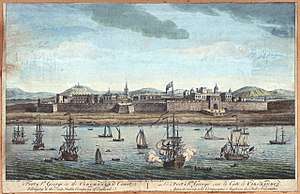Subedar
Subedar (Urdu: صوبیدار) is a historical rank in the Indian Army and Pakistan Army, ranking below British commissioned officers and above non-commissioned officers. The rank was otherwise equivalent to a British captain.
In the Nepalese Army, a subedar is a warrant officer.
History

Thomas Pitt, (1699)[2]
Origin
In British India, subedar or subadar was the second highest rank of Indian officer. It was derived from subahdar, the governor of a province in the Mughal Empire and the Maratha Empire.
A subedar was senior to a jemadar and junior to a subedar-major in the infantry regiments of the Indian Army under British rule. The cavalry equivalent was risaldar. Both jemadars and risaldars wore two stars as rank insignia. [3]
The rank was introduced in the East India Company's presidency armies (the Bengal Army, the Madras Army and the Bombay Army) to make it easier for British officers to communicate with native troops. It was thus important for subedars to have some competence in English. In an order dated November 1755 the structure of an infantry company in the HEIC's newly raised infantry regiments provided for one subedar, four jemadars, 16 NCOs and 90 sepoys (private soldiers). This was to remain the approximate proportion until the number of British junior officers in a regiment increased later in the 18th century. [4]
Until 1866, the rank was the highest a non-European Indian could achieve in the army of British India. A subedar's authority was confined to other Indian troops, and he could not command British troops. Promoted from the ranks and usually advanced through seniority based on long service, the typical subedar of this period was a relatively elderly veteran with limited English whose regimental experience was not matched by formal education or training.[5]
Before the Partition of India, subedars were known as Viceroy's commissioned officers. After 1947, this term was changed to junior commissioned officers.
After independence
After independence, which came in 1947 with the Partition of India, the former Indian Army was divided between India and Pakistan. In the Pakistan Army, the rank has been retained, but the ribbon is now red-green-red. After Bangladesh separated from Pakistan, the Bangladesh Army also retained the rank, changing the ribbon colours to red-purple-red, but in Bangladesh the title of subedar was changed in 1999 to senior warrant officer.
Insignia


Until 1858, subedars wore two epaulettes with small bullion fringes on each shoulder. After 1858, they wore two crossed golden swords, or, in the Gurkha regiments, two crossed golden kukris, on each side of the collar of the tunic or on the right breast of the kurta. After 1900, subedars wore two pips on each shoulder. A red-yellow-red ribbon was introduced under each pip after World War I. After World War II, this ribbon was moved to lie between the shoulder title and the rank insignia (two brass stars on both shoulders).
Maratha empire
In Maratha Empire Brahmins of all the three sections Deshastha, Chitpavan and Karhade were employed as Subedars and Commanders of Hill forts. The Deshastha Brahmins took the lead in the times of Shivaji and his two sons.[6]
Hyderabad state
In the Princely State of Hyderabad under the Nizam, top rank of administrators and tax collectors were called Subedars.
References
- ↑ Blackburn, Terence R. A Miscellany of Mutinies and Massacres in India p. 11
- ↑ https://www.youtube.com/watch?v=I-O5cqkphDI&feature=related
- ↑ Creese, Michael. Swords Trembling in Their Scabbards. The Changing Status of Indian Officers in the Indian Army 1757-1947. p. xiii. ISBN 9-781909-982819.
- ↑ Creese, Michael. Swords Trembling in Their Scabbards. The Changing Status of Indian Officers in the Indian Army 1757-1947. p. 26. ISBN 9-781909-982819.
- ↑ Creese, Michael. Swords Trembling in Their Scabbards. The Changing Status of Indian Officers in the Indian Army 1757-1947. p. 28. ISBN 9-781909-982819.
- ↑ B. K. Ahluwalia; Shashi Ahluwalia (1984). Shivaji and Indian Nationalism. Cultural Publishing House. p. 47.
External links
- www.Bharat-Rakshak.com/Army/Ranks.html - Illustration of various military insignias including three subedar insignia designs.
